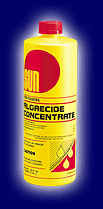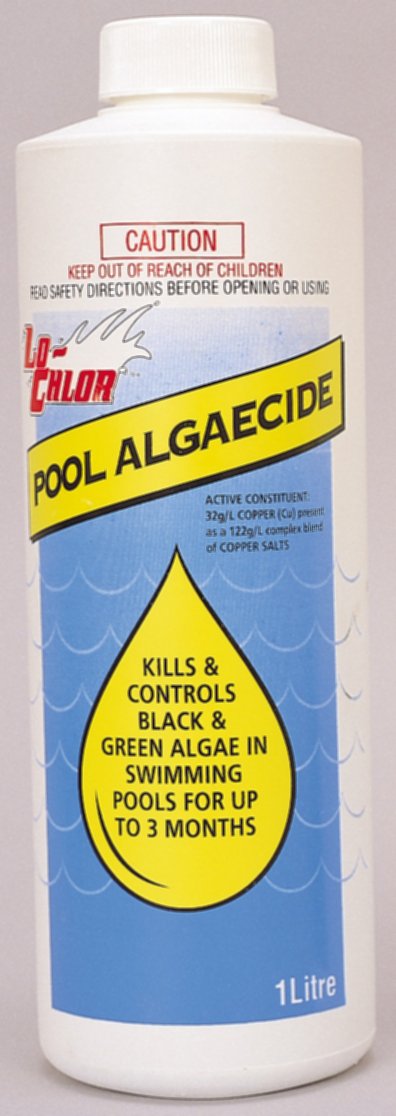
Algae
| Problems Caused by Algae | Types
of Algae | Algae Prevention |Algaecides
| Chlorine Enhancers | Killing
Algae
Every pool owner has, at one time or another, done battle with the occasional algae bloom. Algae spores constantly enter the pool, brought in by wind, rain or even contaminated swimsuits or equipment. When conditions are right, an algae bloom can occur seemingly overnight. These conditions include out of balance water, warm temperatures, sunlight and presence of nitrates and/or carbon dioxide. Of course, a lack of proper circulation, filtration and sanitation may be the primary cause of the algae. The best process is one of elimination.
Algae is a living aquatic creature that multiplies rapidly on warm, sunny days. Containing chlorophyll, algae utilize photosynthesis to grow. That is, they take in carbon dioxide and expend oxygen as a byproduct.
The first noticeable problem is that no one seems to want to go swimming. The second problem is that it requires work and effort and money to rid the water completely of algae. It is therefore best to use preventative chemicals and techniques, described later. Algae can cloud and color the water, making rescue attempts difficult and reducing depth perception of a diver. Algae itself is not harmful to swimmers, but pools with algae may also be harbor to pathogens like E-coli bacteria.
In addition to clogging up sanitation pathways in the water, algae also clogs up the pores in a filter, decreasing filter effectiveness and requiring more backwashing or medium replacement. Algae creates a chlorine demand in the water for itself, actually consuming chlorine that should be working on other contaminants. Algae are kind of like weeds in your garden. Unsightly, unwanted space takers that create more work for the gardener, and sap up nutrients and resources from the flora we wish to grow.
There are over 21,000 known varieties of algae! In the pool business we avoid all of the complication by referring to algae by the color they exhibit.
GREEN ALGAE: An extremely common variety, green algae will usually rear its ugly head immediately following a hazy condition in the water from a lack of proper filtration and/or sanitation. It is frequently found free floating in the water, although it also will cling to the walls. It reduces water clarity and is thereby distinguished from severe copper precipitation, which will impart a clear, green color to the water. Varieties of green algae also appear as "spots" on surfaces, particularly rough areas, or places where circulation is low. They also show up as "sheets", where large wall sections, or even the entire pool, is coated in green slime...UGH!
YELLOW ALGAE: A wall clinging variety, also called mustard algae, is usually found on the shady side of the pool. It is sheet forming, and can be difficult to eradicate completely. Once begun, a pool owner could spend the entire season fighting yellow algae; reinfection is common. This variety is resistant to normal chlorine levels and must be dealt with firmly. Hit it hard!
BLACK ALGAE: Perhaps the most aggravating strain of algae, it has been compared to herpes; "once you've got it, it's there for life". This is not entirely accurate, but the difficulty in eradication is due to the strong roots and protective layers over top of the black algae plant. Black algae will appear as dark black or blue/green spots, usually the size of a pencil eraser tip. Their roots extend into the plaster or tile grout, and unless the roots are destroyed completely, a new head will grow back in the same place. The heads also contain protective layers to keep cell destroying chemicals from entering the organism. Like yellow algae, black strains can bloom even in the presence of normal sanitizing levels and proper filtration.
PINK ALGAE: Not really an algae at all, but a form of bacteria. Appears as spots or streaks in corners and crevices. It is slow to spread and rare that it will bloom over an entire pool.
Proper chemical balance and sanitizer residuals will prevent many opportunities for algae to bloom. high pH and low chlorine (or other sanitizer) can give algae a great start to genesis. General cleanliness of the pool is also important. Organic material and bacteria can contribute to algae growth. Regular brushing of seemingly clean pools is not only good exercise for you, but prevents dirt from harboring in the pores of the plaster, which is a good start for an algae colony.
The use of specialty chemicals or algaecides is recommended to provide a back up to normal sanitation and filtration processes and is completely necessary for many pools. These chemicals are described below:
POTASSIUM TETRABORATE: This chemical, when added to the pool water in proper dosage, prevents algae from converting carbon dioxide into the fuel it needs for growth. Manufactured under the trade name Proteam Supreme. An extraordinary product.
CHITIN: Not an algaecide (meaning to kill algae) per se, but its properties might be called algaestatic (that is, to prevent algae growth). Chitin has the ability to coagulate and remove a wide variety of suspended materials and impurities form the water. This allows the sanitizer to more effectively kill contaminants unobstructed. It also improves the effectiveness of the filtration equipment. Sold under the trade name Sea-Klear, chitin can be a valuable weapon in your algae arsenal.
1. QUATERNARY AMMONIUM COMPOUNDS: A low grade type of algaecide, Quats, as they are called, will usually have "10" somewhere on the bottle, representing 10% active ingredient. Although available at a lower cost, quats tend to produce a small amount of surface foaming. They are most effective as an algaestat, that is, as a prevention, not a cure.
2. POLYMERS: Polymers are long, complicated chemical chains that behave in water both as an algaestat and an algaecide. They are available in percentage strength of 30-60%, are non foaming, and work well as general, all around algae treatments. Poly-Quats are a blended compound of polymer and quats.
3. COPPER BASED: Copper is a proven algaecide and algaestat. Available in varying non foaming strength of 3-10%. It works very well on all types of algae, but it has the drawback of staining white plaster surfaces a light blue/green color if it precipitates out of solution. Most copper based algaecides are chelated, which means that agents have been added to prevent this, such as Lo-Chlor Algaecide.
4. SILVER BASED: Silver has been shown to be an effective bacteriostat, which means that it works to prevent bacteria from reproducing. Non foaming and effective with pink algae. In high doses, reactions with sunlight can cause colloidal silver to deposit as black stains on white plaster. When using copper or silver algaecides, the use of a sequestering agent is recommended.
These are not algaecides, but work to provide a synergistic boost to hypochlorites when added separately, but at the same time. Sold under trade names like Mustard Buster, Yellow-Out or Yellow Treat, it is most effective on, you guessed it, yellow algae. Since it is not an algaecide, the makers are not required to tell what it is made of, but we do know that it works quite well, in conjunction with a little brushing and vacuuming on your part.
First off, balance your water, paying particular attention to pH. Secondly, check your filter system and clean if necessary. Adjust valving for optimum circulation and allow it to run 24 hours a day until the pool clears. Turn on automatic cleaners to help stir things up. Backwash as necessary.
For suspended green algae, shock the pool...hard. Put in as much hypochlorite as it takes to turn the pool a cloudy, bluish/gray color . Brush the walls and floors towards the main drain. Backwash the filter when the pressure gauge indicates the need. Using a flocculent may be a good choice if the pool is extremely "swampy". If you cannot see the bottom of the pool, and it is filled with leaves and debris, it may be wise to drain the pool, acid wash and refill it.
(Please Note that chlorine is a bleaching agent and therefore could cause fading or spotting on vinyl liners. It is therefore suggested that you check with your liner's manufacture prior to super-chlorinating your pool).
After the chlorine level has come down below 5 ppm, add an algaecide and brush the pool again. When it all settles, vacuum the pool (to waste, if possible). Check and rebalance the pool water if necessary.
For algae which is not suspended, but only clinging to the walls, follow the same advice above, first shock with brushing, then add an algaecide, brush again, vacuum to waste (preferred) or vacuum and then backwash the filter. Use of a steel bristled brush is recommended for algae on plaster pools (use nylon brushes on vinyl). Filter, Filter, Filter.
For black algae, the brushing part is very important. You must tear through the protective layers so the chemicals can destroy the plant from the inside out. Pumice stones work well to knock off the heads of black algae. (Don't forget to vacuum them up later, and backwash them out of the filter ASAP). Also effective on the black algae nodules is sprinkling granular trichlor over the spots (of course if they're on the wall this is next to impossible). Rubbing the spots on the walls with a trichlor tablet or stick can also be effective to knock off the heads and get trichlor directly to the roots. Follow up with a dose of copper algaecide, or high strength polymers. Simazine, an herbicide, was a very effective black algae treatment, but is no longer available in America.
If algae has been an ongoing problem in your pool for several years, you may do well to drain the pool. Many years of algae builds up dead algae cells and lots of other solids in the water that contribute to its rejuvenation. Acid washing and/or pressure washing is preferable once drained, to kill the roots of the algae embedded in the plaster. NEXT: change the sand if you have a sand filter or change the cartridge if it is a cartridge type. Sand should be changed every 5-7 yrs (or every 2 if you use baquacil), and cartridge filters should have new elements every 1-2 years. If you have a DE filter, you should remove the elements, spray clean, soak in a 10:1 water/bleach solution, rinse and replace. A well functioning filter will prevent algae.
Another item to look at is the method of sanitation and the type of filtering you have. Far too many pools out there were sold with marginal filter systems, meant to run 24 hrs per day. Well, these systems get old and tired, or the new owners only run it 12 hrs per day (or less). For good algae prevention, we need a combination of good filtration, sanitation and circulation. It may be time to consider changing the old pump and filter. It's cheaper and easier to pay a little up front for more chemicals, electricity or better equipment than all the money and aggravation spent on fighting algae blooms.
Algae | Problems Caused by Algae | Types of Algae | Algae Prevention |Algaecides | Chlorine Enhancers | Killing Algae
To schedule an appointment or for more info please call us at 215-676-0648 or click here to fill out an online information form.


